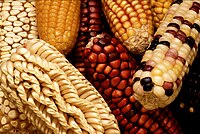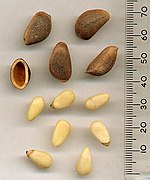مستخدم:Chaos/قائمة البذور المأكولة
A list of edible seeds here includes seeds that are directly foodstuffs, rather than yielding derived products.
A variety of species can provide edible seeds. Of the six major plant parts, seeds are the most important source of human food. The other five major plant parts are roots, stems, leaves, flowers, and fruits. Most edible seeds are angiosperms, but a few are gymnosperms. The most important seed food source is cereals, followed by legumes, and nuts.
The list is divided into the following categories:
- Beans (or Legumes) are protein-rich soft seeds.
- Cereals (or grains) are grass-like crops that are harvested for their dry seeds. These seeds are often ground to make flour. Cereals provide almost half of all calories consumed in the world.[1] Botanically, true cereals are members of the Poaceae or Grass family.
- Pseudocereals are cereal crops that are not members of the Poaceae or Grass Family.
- Nuts are botanically a specific type of fruit but the term is also applied to many edible seeds that are not botanically nuts.
- Gymnosperms produce nut-like seeds but not flowers or fruits.
- Spices are used to flavor food rather than provide nutrients.
Beans[عدل]
See also: Category:Beans
Beans, also known as legumes or pulses include:[2]

- Bambara groundnut
- Broad beans
- Chickpeas
- Cowpeas
- Dry beans, including
- Common bean
- several species of Vigna
- Hyacinth bean
- Lablab
- Lentils
- Lupins
- Peas
- Peanuts
- Pigeon peas
- Soybeans
- Tonka beans
- Velvet beans
- Vetch
- Winged beans
- Yam beans
Cereals[عدل]
{{See also|Category:Cereals}}

True cereals are the seeds of certain species of grass. Three - maize, wheat and rice - account for about half of the calories consumed by people every year.[1] Grains can be ground to make flour, used as the basis of bread, cake, noodles or other food products. They can also be boiled or steamed, either whole or ground, and eaten as is. Many cereals are present or past staple foods, provided a large fraction of the calories in the places that they are eaten. Cereals include:
- شعير
- Fonio
- Kamut
- Maize
- Millet
- Oats
- Palmer's grass
- Rice
- Rye
- Sorghum
- Spelt
- Teff
- Triticale
- Wheat
- Wild rice
Pseudocereals[عدل]

- Breadnut
- Buckwheat
- Cattail
- Chia
- Cockscomb
- Grain amaranth
- Kañiwa
- Quinoa
- Wattleseed (also called acacia seed)
Nuts[عدل]
See also: List of edible nuts

According to the botanical definition, nuts are a particular kind of seed.[3] Walnuts and acorns are example of nuts, under this definition. In culinary terms, however, the term is used more broadly to include fruits that are not botanically qualified as nuts, but that have a similar appearance and culinary role. Examples of culinary nuts include almonds, peanuts and cashews.[4][5]
- Almond
- زان
- Butternut
- Brazilnut
- Candlenut
- Cashew
- Chestnuts, including:
- Colocynth
- Cucurbita ficifolia
- Filbert
- Hickory, including
- Kola nut
- Macadamia
- Mamoncillo
- Maya nut
- Oak acorns
- Ogbono nut
- Paradise nut
- Pili nut
- Pistachio
- Walnut
Nut-like gymnosperm seeds[عدل]

- Cycads
- Ginkgo
- Gnetum gnemon
- Juniper
- Monkey-puzzle
- Pine nuts, including
- Podocarps
Spices[عدل]
See also: List of herbs and spices

Seeds that are used to flavor other foods include:[6]
- Ajowan seed
- Anise seed
- Cardamom seed
- Caraway seed
- Celery seed
- Cubeb seed
- Cumin seed
- Coriander seed
- Dill seed
- Fennel seed
- Fenugreek seed
- Juniper seed
- Mace
- Mustard seed
- Nigella seed
- Nutmeg
- Pomegranate seed
- Poppy seed
- Sesame seed
- Vanilla
Miscellaneous[عدل]
References[عدل]
- ^ أ ب FAO. "ProdSTAT". FAOSTAT. اطلع عليه بتاريخ 2006-12-26.
- ^ "Pulses and derived products". Definition and Classification of Commodities. Food and Agriculture Organization of the United Nations. 1994. اطلع عليه بتاريخ 2006-12-26.
- ^ "Nut". Biology Online Dictionary. October 3 2005. اطلع عليه بتاريخ 2006-12-26.
{{استشهاد ويب}}: تحقق من التاريخ في:|date=(مساعدة) - ^ "Nut". The Columbia Online Encyclopedia. 2003. اطلع عليه بتاريخ 2006-12-26.
- ^ "Nuts and derived products". Definition and Classification of Commodities. Food and Agriculture Organization of the United Nations. 1996. اطلع عليه بتاريخ 2006-12-26.
- ^ "Gernot Katzer's Spice Pages". اطلع عليه بتاريخ 2006-12-26.
- Bailey, L.H., Bailey, E.Z. and Bailey Hortorium Staff (1976). Hortus Third. New York: Macmillan.
{{استشهاد بكتاب}}: صيانة الاستشهاد: أسماء متعددة: قائمة المؤلفين (link) - Lewington, A. (1990). Plants for People. Cambridge, MA: Oxford University Press.
انظر أيضا[عدل]
- List of vegetable oils
- List of seed-based snacks
- Eastern Agricultural Complex
- Nut (fruit)
- Pulse
- Seed
[[:تصنيف:قوائم الطعام|بذور]] [[hr:Popis žitarica]] [[lt:Valgomų sėklų sąrašas]]
